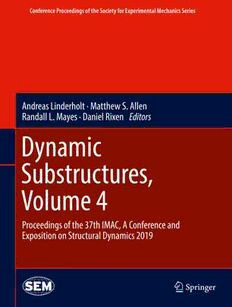Table Of ContentConference Proceedings of the Society for Experimental Mechanics Series
Andreas Linderholt · Matthew S. Allen
Randall L. Mayes · Daniel Rixen Editors
Dynamic
Substructures,
Volume 4
Proceedings of the 37th IMAC, A Conference and
Exposition on Structural Dynamics 2019
ConferenceProceedingsoftheSocietyforExperimentalMechanicsSeries
SeriesEditor
KristinB.Zimmerman,Ph.D.
SocietyforExperimentalMechanics,Inc.,
Bethel,CT,USA
Moreinformationaboutthisseriesathttp://www.springer.com/series/8922
Andreas Linderholt • Matthew S. Allen (cid:129) Randall L. Mayes (cid:129) Daniel Rixen
Editors
Dynamic Substructures, Volume 4
Proceedings of the 37th IMAC, A Conference and Exposition
on Structural Dynamics 2019
123
Editors
AndreasLinderholt MatthewS.Allen
MechanicalEngineering UniversityofWisconsin–Madison
LinnaeusUniversity Madison,WI,USA
Växjö,Sweden
DanielRixen
RandallL.Mayes LehrstuhlfürAngewandteMechanik
Bldg860Room201D,MS0557 TechnischeUniversitatMunchen
SandiaNationalLaboratory Garching,Germany
Albuquerque,NM,USA
ISSN2191-5644 ISSN2191-5652 (electronic)
ConferenceProceedingsoftheSocietyforExperimentalMechanicsSeries
ISBN978-3-030-12183-9 ISBN978-3-030-12184-6 (eBook)
https://doi.org/10.1007/978-3-030-12184-6
©SocietyforExperimentalMechanics,Inc.2020
Thisworkissubjecttocopyright.AllrightsarereservedbythePublisher,whetherthewholeorpartofthematerialisconcerned,specificallytherights
oftranslation,reprinting,reuseofillustrations,recitation,broadcasting,reproductiononmicrofilmsorinanyotherphysicalway,andtransmissionor
informationstorageandretrieval,electronicadaptation,computersoftware,orbysimilarordissimilarmethodologynowknownorhereafterdeveloped.
Theuseofgeneraldescriptivenames,registerednames,trademarks,servicemarks,etc.inthispublicationdoesnotimply,evenintheabsenceofaspecific
statement,thatsuchnamesareexemptfromtherelevantprotectivelawsandregulationsandthereforefreeforgeneraluse.
Thepublisher,theauthors,andtheeditorsaresafetoassumethattheadviceandinformationinthisbookarebelievedtobetrueandaccurateatthedate
ofpublication.Neitherthepublishernortheauthorsortheeditorsgiveawarranty,expressorimplied,withrespecttothematerialcontainedhereinorfor
anyerrorsoromissionsthatmayhavebeenmade.Thepublisherremainsneutralwithregardtojurisdictionalclaimsinpublishedmapsandinstitutional
affiliations.
ThisSpringerimprintispublishedbytheregisteredcompanySpringerNatureSwitzerlandAG.
Theregisteredcompanyaddressis:Gewerbestrasse11,6330Cham,Switzerland
Preface
Dynamic Substructures represents one of eight volumes of technical papers presented at the 37th IMAC, A Conference
and Exposition on Structural Dynamics, organized by the Society for Experimental Mechanics and held in Orlando,
Florida, on January 28–31, 2019. The full proceedings also include volumes on Nonlinear Structures & Systems;
Dynamics of Civil Structures; Model Validation and Uncertainty Quantification; Special Topics in Structural Dynamics
&ExperimentalTechniques;RotatingMachinery,OpticalMethods&ScanningLDVMethods;SensorsandInstrumentation,
Aircraft/Aerospace,EnergyHarvesting&DynamicEnvironmentsTesting;andTopicsinModalAnalysis&Testing.
Eachcollectionpresentsearlyfindingsfromexperimentalandcomputationalinvestigationsonanimportantareawithin
structuraldynamics.Coupledstructuresorsubstructuringisoneoftheseareas.
Substructuringisageneralparadigminengineeringdynamicswhereacomplicatedsystemisanalyzedbyconsideringthe
dynamicinteractionsbetweensubcomponents.Innumericalsimulations,substructuringallowsonetoreducethecomplexity
of parts of the system in order to construct a computationally efficient model of the assembled system. A subcomponent
model can also be derived experimentally, allowing one to predict the dynamic behavior of an assembly by combining
experimentally and/or analytically derived models. This can be advantageous for subcomponents that are expensive or
difficult to model analytically. Substructuring can also be used to couple numerical simulation with real-time testing of
components.Suchapproachesareknownashardware-in-the-looporhybridtesting.
Whetherexperimentalornumerical,allsubstructuringapproacheshaveacommonbasis,namely,theequilibriumofthe
substructures under the action of the applied and interface forces and the compatibility of displacements at the interfaces
of the subcomponents. Experimental substructuring requires special care in the way the measurements are obtained and
processedinordertoassurethatmeasurementinaccuraciesandnoisedonotinvalidatetheresults.Innumericalapproaches,
the fundamental questis theefficient computation of reduced order models describing thesubstructure’s dynamic motion.
Forhardware-in-the-loopapplications,difficultiesincludethefastcomputationofthenumericalcomponentsandtheproper
sensingandactuationofthehardwarecomponent.Recentadvancesinexperimentaltechniques,sensor/actuatortechnologies,
novel numerical methods, and parallel computing have rekindled interest in substructuring in recent years leading to new
insightsandimprovedexperimentalandanalyticaltechniques.
Theorganizerswouldliketothanktheauthors,presenters,sessionorganizers,andsessionchairsfortheirparticipationin
thistrack.
Växjö,Sweden A.Linderholt
Madison,WI,USA M.Allen
Albuquerque,NM,USA R.Mayes
Garching,Germany D.Rixen
v
Contents
1 UsingLaserVibrometryforPreciseFRFMeasurementsinExperimentalSubstructuring .................... 1
FrancescoTrainotti,TobiasF.C.Berninger,andDanielJ.Rixen
2 APrioriInterfaceReductionforSubstructuringofMultistageBladedDisks.................................... 13
LukasSchwerdt,LarsPanning-vonScheidt,andJörgWallaschek
3 Using Hybrid Modal Substructuring with a Complex Transmission Simulator to Model
anElectrodynamicShaker.............................................................................................. 23
BenjaminMoldenhauer,MattAllen,WashingtonJ.DeLima,andEricDodgen
4 HybridSubstructureAssemblyTechniquesforEfficientandRobustOptimizationofAdditional
StructuresinLatePhaseNVHDesign:AComparison ............................................................. 35
BenjaminKammermeier,JohannesMayet,andDanielJ.Rixen
5 WorkpieceCouplinginMachineToolsUsingExperimental-AnalyticalDynamicSubstructuring ............ 47
PrateekChavan,ChristianBrecher,MarcelFey,andMatthäusLoba
6 MechanicalCharacterizationandNumericalModelingofHighDensityPolyethylenePipes .................. 57
MehrzadTaherzadehboroujeniandScottW.Case
7 StudyonDynamicStiffnessCharacteristicofPrimarySuspensionforHigh-SpeedEMU ..................... 67
XiugangWang,XiaoningCao,AiqinTian,JianSu,WeiXue,andShenZhan
8 Test-BasedModeling,SourceCharacterizationandDynamicSubstructuringTechniquesApplied
onaModularIndustrialDemonstrator............................................................................... 73
A.M.Steenhoek,M.W.vander Kooij,M.L.J.Verhees,D.D.vanden Bosch,andJ.M.Harvie
9 DevelopmentofaLowCostAutomaticModalHammerforApplicationsinSubstructuring .................. 77
JohannesMaierhofer,AhmedElMahmoudi,andDanielJ.Rixen
10 UsingSEMMtoIdentifytheJointDynamicsinMultipleDegreesofFreedomWithoutMeasuring
Interfaces................................................................................................................. 87
S.W.B.KlaassenandD.J.Rixen
11 OverviewofFreeInterfaceSubstructuringApproachesforSystemswithArbitraryViscousDamping
inDynamicSubstructuring............................................................................................. 101
FabianM.Gruber,DennisBerninger,andDanielJ.Rixen
12 ModelUpdatingofFluid-StructureInteractionEffectsonPipingSystem ....................................... 133
SrijanRajbamshi,QintaoGuo,andMingZhan
13 VehicleDrivelineBenchmarkingtoSupportPredictiveCAEModelingDevelopment.......................... 141
J.Furlich,J.Blough,andD.Robinette
14 AProposalofDynamicBehaviourDesignBasedonModeShapeTracing:NumericalApplication
toaMotorbikeFrame................................................................................................... 149
ElvioBonisoli,DomenicoLisitano,LucaDimauro,andLorenzoPeroni
vii
viii Contents
15 RapidSeismicRiskAssessmentofStructureswithGaussianProcessRegression............................... 159
MohamadrezaSheibani,GeOu,andShandianZhe
16 ModelingRail-VehicleCoupledDynamicsbyaTime-VaryingSubstructuringScheme ........................ 167
LuigiCarassale,PaoloSilvestri,RoaldLengu,andPaoloMazzaron
17 PlanningofaBlack-BoxBenchmarkStructureforDynamicSubstructuring.................................... 173
D.RoettgenandA.Linderholt
18 StudyontheTechnologyofReliableLifePredictionofPlateHeatExchangerforShip ........................ 177
LongboLiu,NaHan,LingliFu,andJunYao
19 Real-TimeHybridSubstructuringResultsoftheMarsPathfinderParachuteDeployment.................... 183
MichaelJ.HarrisandRichardE.Christenson
Chapter 1
Using Laser Vibrometry for Precise FRF Measurements
in Experimental Substructuring
FrancescoTrainotti,TobiasF.C.Berninger,andDanielJ.Rixen
Abstract The acquisition of high quality FRF measurements is a key factor for a successful implementation of cou-
pling/decouplingtechniquesinExperimentalDynamicSubstructuring.Althoughtheuseofpiezoaccelerometersasresponse
transducers is very popular for impact testing due to its easy and fast implementation, the level of accuracy could not
be adequate in certain applications. The laser technology provides a non-invasive alternative to standard piezo devices.
The choice of a non-contact measurement technique allows to minimize the impact of external dynamic systems on the
test component during the measurement process. In this paper, a validation of Lagrange Multiplier—Frequency Based
Substructuring coupling by means of a Virtual Point Reduction is performed on a benchmark structure with a non-stiff
interface.ThenecessaryFRFdataisacquiredtwice,usingaccelerometersandalaserDopplervibrometerrespectively.Both
couplingresultsarecomparedtoeachotherandareshowntomatchverywellsimulationdatauptoahighfrequencyrange.
Theresultsunderlinethepotentialofhighquality,non-intrusivemeasurementsforFrequencyBasedSubstructuring.
Keywords Experimentaldynamics · DynamicSubstructuring · FrequencyBasedSubstructuring · VirtualPoint
Transformation · FRFmeasurements · Laservibrometry
1.1 Introduction
InDynamicSubstructuring(DS)theconceptofmodulardesigncanbereinterpretedfromastructuraldynamicspointofview,
making possible the modelling, analysis and optimization of a complex system on a substructure level. Although various
methodologiesandtechnicalsolutionswithinDSarewelldocumented[1],itstillremainschallengingtovalidatetheoretical
concepts in the framework of an industrial application. Significant difficulties in Experimental Dynamic Substructuring
(EDS) concern the coupling/decoupling of the measured components. In this context, a frequency-based formulation of
theproblemisrecommendedasitdirectlyincludesthemeasuredFrequencyResponseFunctions(FRFs)intheimplemented
methods.Furthermore,apropercouplingofsubstructuresstronglydependsonacompleteandaccuratemodellingofinterface
dynamics. It is common practice to ‘weaken’ the interface problem by projecting the dynamics into a subspace composed
by Interface Deformation Modes (IDMs), which aren’t global vibration modes but rather kinematic assumptions of the
local deformation behaviour at the interface. This approach uses so-called virtual points to connect the components as in
finite element models, overcoming some of the issues arising from experimental practice [2]. Inaccuracies and sources of
errorrelatedtotheapplicationofexperimentalFrequencyBasedSubstructuring(FBS)techniquesbymeansofVirtualPoint
Transformation(VPT)arisefromthecomplexitiesassociatedwithbothreliableandaccuratedataacquisitionandhighquality
interfacemodeling.RegardingtheerrorsexclusivelygeneratedbyFRFmeasurements,differentsourcesofdisturbancescan
befurtherdistinguished:
(cid:129) Modificationofthesignalarisingfromdataacquisitionandsignalprocessing[3,4].
(cid:129) Influence of external dynamic systems on the measured component (e.g. support mechanisms, attached measurement
devices)[5].
(cid:129) Randomandsystematicerrors(e.g.environmentalnoise,sensornoiseandpositioning).
Moreover,theuncertaintyonthemeasurementscanbehighlyamplifiedbytheDSalgorithmduetonumericalinstabilities
andinducesspuriouspeaksandinaccuraciesinthecouplingresults[6,7].
F.Trainotti((cid:2))·T.F.C.Berninger·D.J.Rixen
FacultyofMechanicalEngineering,TechnicalUniversityofMunich,Garching,Germany
e-mail:[email protected];[email protected];[email protected]
©SocietyforExperimentalMechanics,Inc.2020 1
A.Linderholtetal.,DynamicSubstructures,Volume4,ConferenceProceedingsoftheSocietyforExperimentalMechanicsSeries,
https://doi.org/10.1007/978-3-030-12184-6_1
2 F.Trainottietal.
In particular, the use of standard measurement devices like piezo accelerometers in the FRFs acquisition process may
notbesuitableforapplicationsrequiringahighlevelofaccuracy.Therefore,avalidalternativeformotiondetectioncanbe
identifiedintheuseoflaserinterferometry,thankstoitsnon-invasiveandhighqualitymeasurementtechnique.
Inthiscontribution,thepotentialoflasertechnologyintheacquisitionofFRFswithinFBSisinvestigated.Thereliability
oflasermeasurementscompared tothosetakenwithstandardaccelerometers isevaluated throughtheanalysisofthefinal
couplingresults.
In Sect.1.2, the theoretical background on Experimental Dynamic Substructuring is recalled, with particular focus on
frequency-basedapproachesandinterfacemodellingtechniques.ThelaservibrometryisshortlydiscussedinSect.1.3along
withitsadvantagesanddrawbacksovertraditionalmeasurementtechniques.InSect.1.4,twomeasurementcampaignsare
carried out, one with accelerometers and the other with a laser Doppler vibrometer. A DS coupling is performed and the
resultsofbothcasestudiesarecompared.AbriefsummaryoffindingsandconclusionsisgiveninSect.1.5.
1.2 ExperimentalDynamicSubstructuring
This section briefly reviews the theoretical concepts underlying the Experimental Dynamic Substructuring. Inparticular, a
generaloverviewofFrequencyBasedSubstructuringandVirtualPointTransformationisprovidedinSects.1.2.1and1.2.2
respectively.
1.2.1 Frequency BasedSubstructuring
TheassemblyprocedureinthefrequencydomainaccordingtoadualapproachisnamedLagrangeMultiplier—Frequency
BasedSubstructuring(LM-FBS)[1,8,9].Thismethod,whichoperateswithadmittancenotation,evaluateslocallyasetof
interfaceDoFsforeachsinglesubstructureinthesystemandconsiderstheinterfaceforcesasunknownvariables.Theaim
ofLM-FBSistoderivetheadmittanceoftheassembledsystemYAB fromtheseparateadmittancesofthetwosubsystems
YAandYB.
ConsiderthesystemdepictedinFig.1.1.Thesubsystems’admittancesareknownandthesubstructures’DoFsaregrouped
in internal DoFs ((∗)A and (∗)B) and interface DoFs ((∗)A and (∗)B). The vectors of displacements, applied forces and
1 3 2 2
reactionforcesaredenotedbyu,f andg respectively.Thegoverningequationofmotionfortheuncoupledsysteminthe
frequencydomainiswritteninacompactform:
⎡ ⎤ ⎡ ⎤⎛⎡ ⎤ ⎡ ⎤⎞
uA YA YA 0 0 fA 0
1 11 12 1
u=Y(f +g) (cid:3)⇒ ⎢⎢⎣uuBA2⎥⎥⎦=⎢⎢⎣Y0A21 Y0A22 Y0B Y0B⎥⎥⎦⎜⎜⎝⎢⎢⎣ffBA2⎥⎥⎦+⎢⎢⎣ggBA2⎥⎥⎦⎟⎟⎠ (1.1)
2 22 23 2 2
uB 0 0 YB YB fB 0
3 32 33 3
The matrixY represents theadmittance oftheuncoupled system,builtinablock diagonal formby theadmittances ofthe
subsystemsYAandYB.
Fig.1.1 AssemblyofsubsystemsAandBattheinterfaceDoFsu2

